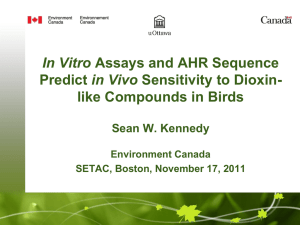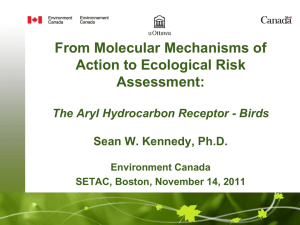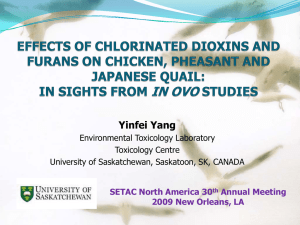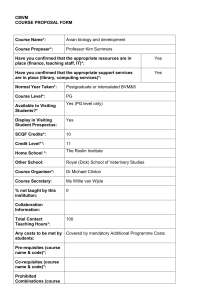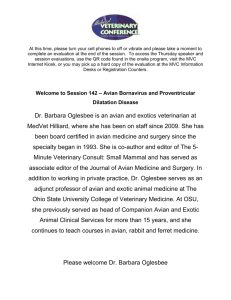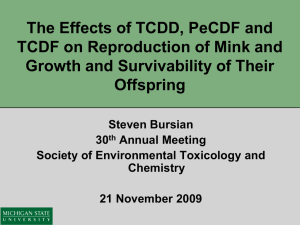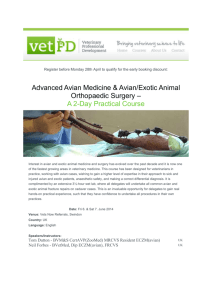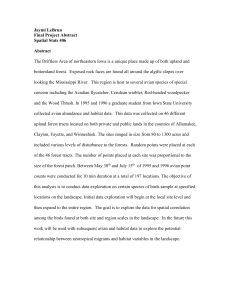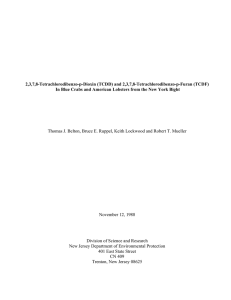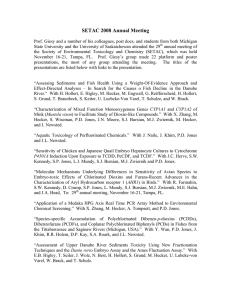The AHR Ligand Binding Domain - Role in Dioxin-like Compounds
advertisement
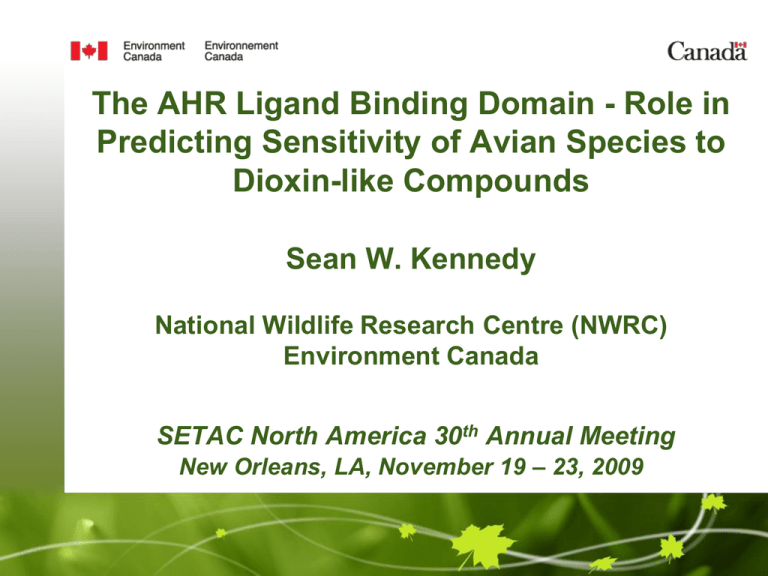
The AHR Ligand Binding Domain - Role in Predicting Sensitivity of Avian Species to Dioxin-like Compounds Sean W. Kennedy National Wildlife Research Centre (NWRC) Environment Canada SETAC North America 30th Annual Meeting New Orleans, LA, November 19 – 23, 2009 • Environment Canada & University of Ottawa – • Sean Kennedy, Reza Farmahin, Jessica Hervé, Jessica Head, Lukas Mundy, Doug Crump, Stephanie Jones, Dongmei Wu, Brian Collins Michigan State University – • Matthew Zwiernik, Steven Bursian, Andrew Cohen-Barnhouse, Tim Fredericks, Jane Link, Rita Seston, Sarah Coefield, Dustin Tazelaar, Patrick Bradley University of Saskatchewan – • John Giesy, Steve Wiseman, Paul Jones, Yi Wan, Yinfei Yang Woods Holes Oceanographic Institution – • Mark Hahn, Sibel Karchner, Diana Franks ENTRIX Inc. – Denise Kay, John Newsted, Shaun Roark Funding for Tittabawasee River Avian Research • The Dow Chemical Company – • • • Un-restricted grant to Michigan State University, University of Saskatchewan and University of Ottawa Environment Canada – STAGE Program le Fond Québécois de la Recherche sur la Nature et les Technologies Other funds to Michigan State University, University of Saskatchewan and Woods Hole Oceanographic Institution SETAC 2009 Tittabawasee River Avian Research Presentations • Field studies – – – – – – – – Seston et al. Fredricks et al. Fredricks et al. Williams et al. Fredricks et al. Tazelaar et al. Coefield et al. Seston et al. Abstract 248 Abstract 249 Abstract MP 179 Abstract MP 180 Abstract MP 181 Abstract MP 182 Abstract MP 183 Abstract MP 184 SETAC 2009 Tittabawasee River Avian Research Presentations • Laboratory studies – – – – Kennedy et al. Yang et al. Cohen-Barnhouse et al. Cohen-Barnhouse et al. Abstract 247 Abstract 537 Abstract MP 177 Abstract MP 178 This Presentation • The Tittabawasee River avian research projects: – The goals of our field and laboratory studies • Laboratory studies with chicken, pheasant and Japanese quail: – A few highlights from: ▪ egg injection studies ▪ in vitro hepatocyte studies – The aryl hydrocarbon receptor (AHR) research: ▪ objective ▪ recent results and future plans The Tittabawasee River Avian Research Project • General goal is to determine the effects of environmental • exposure to dibenzo-p-dioxins and dibenzofurans in wild birds The research includes: – – – – Field studies with several avian species Chemical residue analysis Biomarker analysis Laboratory studies (egg injection and in vitro studies) • Problem – there are large differences in sensitivity to • ‘dioxins and furans’ among avian species – major challenge to risk assessments Solution – develop methods to predict species sensitivity Dioxins and Furans of Particular Interest in the Avian Laboratory Studies 2,3,7,8-tetrachlorodibenzo-p-dioxin (TCDD) 2,3,7,8-tetrachlorodibenzofuran (TCDF) 2,3,4,7,8-pentachlorodibenzofuran (PeCDF) 8 Current Opinion of the World Health Organization 2,3,7,8-tetrachlorodibenzo-p-dioxin (TCDD) 2,3,7,8-tetrachlorodibenzofuran (TCDF) 2,3,4,7,8-pentachlorodibenzofuran (PeCDF) These three DLCs are Equipotent Toxicants in Birds (i.e., TEFs for TCDD, TCDF and PeCDF = 1.0) 9 The Laboratory Studies • Egg injection and in vitro studies • Three species: chicken, pheasant, Japanese quail • In vitro studies include: – – – – CYP1A induction in primary hepatocyte cultures Aryl hydrocarbon receptor (AHR) sequencing Binding affinity of TCDD, PeCDF and TCDF to the AHR AHR expression Egg Injection and Cell Culture In Ovo Injection Primary Cell Cultures Neuronal Hepatocyte Cardiomyocyte CYP1A Induction in Hepatocyte Cultures Incubation Add ‘dioxin-like’ chemical Pool of livers 24 hour exposure EROD & CYP1A mRNA Cytotoxicity Simplified Dioxin Response Pathway Dioxin 1. KEY STEP FOR SUBSEQUENT TOXIC EFFECTS 2. CYP1A mRNA 1. Dioxin binds and activates AHR 2. CYP1A mRNA increases 3. CYP1A protein (EROD) 3. CYP1A protein increases Concentration-Dependent Effects of TCDD, PeCDF and TCDF on EROD Activity 400 300 200 100 ReP ReP PeCDF 3.0 500 PeCDF 13 TCDD 1.0 400 TCDD 1.0 300 TCDF TCDF 0.8 200 200 100 100 0 0 0.1 Concentration (nM) 2 10 10 4 10 3 10 2 -1 10 0 10 1 10 D Concentration (nM) M SO 2 10 10 4 10 3 10 2 -1 10 0 10 1 10 0 M SO 500 2 300 ReP PeCDF 1.0 TCDD 1.0 TCDF 1.0 Quail 10 10 4 10 3 10 2 -1 10 0 10 1 10 400 Pheasant D M SO 500 D EROD activity (pmol/min/mg protein) Chicken Concentration (nM) Hervé et al. ToxSci Advance Access, Nov. 1, 2009 CYP1A Induction in Hepatocyte Cultures • When exposed to TCDD or TCDF > > Hervé et al. ToxSci Advance Access, Nov. 1, 2009 When exposed to PeCDF = = 15 LD50 (nmol/kg egg) Egg Injection Toxicity Data Compared to CYP1A Induction in Hepatocyte Cultures 10 3 R2 = 0.77 p = 0.0001 10 2 tern PCB126 turkey PCB126 quail TCDD quail TCDF 10 1 pheasant TCDD quail PeCDF cormorant TCDD chicken PCB126 10 0 chicken TCDD pheasant TCDF pheasant PeCDF chicken TCDF 10 -2 10 -1 10 0 10 1 EC50 (nM) LD50 data: Cohen-Barnhouse; Head & Kennedy (Ecotoxicology, 2009) EC50 data: Hervé et al. (Tox. Sci., 2009); Head & Kennedy (Ecotoxicology, 2009) 16 Avian Potency Values - Reloaded •TCDD is not the most potent dioxin/furan in all avian species • The LD50 of PeCDF is 6 times lower than the LD50 of TCDD in pheasant and quail • PeCDF is a more potent CYP1A inducer than TCDD in pheasant hepatocytes (3-5 fold) and quail hepatocytes (13-30 fold) cultures Abstracts MP 177 and MP 178 Hervé et al. Tox. Sci. (2009) in press Possible implications to avian TEF values The Avian AHR Genotyping Project Goal: • Develop a method to determine the sensitivity of any avian species to the toxic and molecular effects of ‘dioxin-like’ compounds that is based upon AHR sequence – – – – – Karchner et al., PNAS (2006) Head et al. Environ. Sci. Technol. (2008) Farmahin et al. (2010) Head et al. (2010) Kennedy et al. (2010) The Key Role of the Ligand Binding Domain (LBD) Within the Avian AHR Gene NH3+ DBD LBD TAD COO- NH3+ DBD LBD TAD COO- chicken common tern chicken common tern Avian AHR Amino Acids # 324 and # 380 Insensitive Position 324 Position 380 Ala Val Ser Val/Ala Moderately Insensitive sensitive? Very sensitive Ile Moderately sensitive? Very sensitive Ile/Ser Site-directed Mutagenesis JQ-V324I JQ-V380S EC50(nM) 18 0.22 chicken J.quail 1.5 0.7 JQ-V324I JQ-A380S CYP1A Expression in COS-7 Cells AHR gene ARNT gene CYP1A reporter gene DLC Luciferase reagent The AHR Genotyping Project - Current Research • Ligand binding domain sequenced for 72 wild avian species • Using site-directed mutagenesis (‘card tricks’) all sub-types of constructs were prepared • The predicted sensitivity of all sub-types of AHR constructs is being tested with TCDD, PeCDF and TCDF • Methods to predict avian species sensitivity to dioxin-like chemicals based upon AHR genotype will be available soon LD50 (nmol/kg egg) Egg Injection Toxicity Data Compared to CYP1A Induction in Hepatocyte Cultures 10 3 R2 = 0.77 p = 0.0001 10 2 tern PCB126 turkey PCB126 quail TCDD quail TCDF 10 1 pheasant TCDD quail PeCDF cormorant TCDD chicken PCB126 10 0 chicken TCDD pheasant TCDF pheasant PeCDF chicken TCDF 10 -2 10 -1 10 0 10 1 EC50 (nM) LD50 data: Cohen-Barnhouse; Head & Kennedy (Ecotoxicology, 2009) EC50 data: Hervé et al. (Tox. Sci., 2009); Head & Kennedy (Ecotoxicology, 2009) 25 Costumes & Card Tricks NWRC Molecular Toxicology Lab
